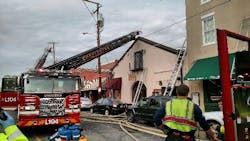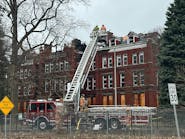Progress Pushes Charleston Firefighters after Tragedy
Source Firehouse.com News
Firehouse.com talked with interim Fire Chief John Tippett Jr. and battalion chiefs John Cole and Jack deTournillon to see where the Charleston, SC, Fire Department is today, as firefighters prepare to mark the 10th anniversary of the Sofa Super Store fire on Sunday.
CHARLESTON, SC—In the 10 years since Charleston lost nine firefighters in the June 18, 2007, Sofa Super Store fire, the department has seen significant changes from the ground up and members say they are proud of the progress.
Following the tragic fire, investigations conducted by the National Institute for Occupational Safety and Health (NIOSH), National Institute for Standards and Technology (NIST Part 1 and Part 2) and an independent review panel led by Gordon Routley—who wrote the Routley Report, laid the framework for changes that the department needed to consider.
The department had a lot of ground to cover, based on the findings of the various reports and the American fire service was watching.
Then-Mayor Joe Riley named Montgomery County, MD, Fire Chief Tom Carr as Charleston's new chief in September 2008.
"It is a great honor to be selected as chief of the City of Charleston Fire Department," Carr told Firehouse.com. "I am committed to bringing to Charleston the most progressive approaches of the fire service in United States. I look forward to working with the exceptional men and women of the City of Charleston Fire Department as we work together to make a great department better and the citizens of Charleston even safer."
Progress and change
Members of the department have made a lot of progress based on the findings of the reports and it's something they continue to refine.
“We’ve probably grown in the last 10 years, what most departments would do in 30 to 40 years," Battalion Chief Jack deTournillon said. "It’s been at a blistering pace.”
A captain at Engine 10, deTournillon saw three of the firefighters who would perish that night as he left the station the morning of June 18, 2007. He was home with family when he got word of the fire and quickly responded to the scene to help.
“The biggest thing was just the eye opening … how much we were not doing or how much we were in the dark as far as what a progressive fire department is supposed to do," deTournillon said. "We never sought any outside training, so we only trained within and when the Routley Report was released, it really showed how far we were behind the ball.”
John Cole was an engineer the day of the fire. He was off-duty when the fire was reported and was on the scene within 20 minutes and assigned to fire attack.
“The event itself made me want to do all I could do to honor the members we lost and that’s why I stayed on the job," Cole said, who was recently promoted to battalion chief. "I wanted to continue to educate myself and do as much as I could for the members around me so that it’s a worthy tribute to those members we lost."
John Tippett Jr. became a deputy chief in Charleston in 2009 after leaving a career in Montgomery County, MD. In April of this year, Tippett was appointed interim fire chief in Charleston.
“The single biggest impact on my career in Charleston has been the response of the people that were here at the time and are still working with us today,” he said. “They are a dedicated bunch and have survived something that very few people in the fire service can say they have and the demand that they make changes, not at their pace, but at those driven by OSHA and other reports.”
Honoring the Charleston 9
Charleston firefighters remember those who died in 2007 in myriad ways, including wearing a Charleston 9 pin on their dress uniform, the design on their work shirts and each apparatus has a Charleston 9 logo, along with the names of the fallen firefighters.
From recruits to firefighters who worked beside the fallen members, everyone honors them in their own way, Cole said.
Each recruit class goes to the site of the Sofa Super Store fire to learn about the tragedy, said deTournillon, adding that the visit is set up “to impress upon them not only how important it is, but just to do the right stuff…have safety in mind, stay on top of your A-game and how quickly things can go bad. It’s all right there to show them.”
“A lot of us stuck around because we wanted to be part of the growth and part of the progression and I think that’s how we, individually, honor the nine," Cole said.
"What I see is a workforce that is significantly more confident than it was when I arrived," Tippet said. "Their level of competence from that level of confidence has made them more willing to share the knowledge they obtained....I see a very inspiring workforce here that makes it worth getting up to work every day.”
Assessing fireground risk and incident command
According to deTournillon, much of the decision making on the fireground before 2007 was based on gut instincts and experience. A structured risk management process was introduced to the department shortly after the fire and the process includes a strategy where firefighter safety is paramount and has to be addressed before fire attack operations commence.
“Through the efforts of the guys who were ready to implement the changes immediately, it made for an easier transition throughout the entire department,” Tippett said.
The department adopted new ideas for incident command to help company and chief officers manage scenes in a more effective way.
“We really started working on incident command at the company level,” Cole said. “That began with company officers working on their size-ups and doing those all the time.”
Company officers received training on how to complete effective size-ups, including how to read the structure and smoke and to know what resources are needed.
“It was just taking things one step at a time,” deTournillon said. “We started with size-up language and I would print something up and laminate it and put it on the dash of the engine … and then I would take command in formal manner, which was something we didn’t do before." He refined his size-up skills by practicing on EMS calls.
Cole said that before the 2007 fire, incident commanders were mobile on the fireground—walking around and checking on conditions or checking in with crews.
After the fire, Charleston’s chief officers began managing scenes from inside the command vehicle and Cole said that improved the chief’s ability to monitor fireground communications and the scene without distractions.
A second chief officer was assigned to working fires to handle accountability and sits inside the command vehicle with the incident commander to track resources.
“We learned to have people in our pocket for when the incident throws you a curveball," Cole said.
Resource management
Tippett said Charleston adapted the concept of frontloading resources—adding enough units to the assignment to handle the duties on the fireground. Charleston was accustomed to using the least amount of resources possible.
Before the 2007 tragedy, two engines, one ladder and one battalion chief would be assigned to any structure fire. Today, four engines, one ladder, one heavy rescue, three battalion chiefs are dispatched, with one engine company dedicated to rapid intervention. Staffing has also increased on apparatus, putting even more firefighters on the fireground.
Each of those companies has predetermined tasks to complete on the fireground, which has cut down on the confusion about tasks being completed.
In the past, ladder crews often staffed hoselines, but the department has focused on training ladder crews for ventilation and softening the structure. Part of the change included the need for engine apparatus to leave a position in front of the structure for ladder trucks.
Equipment changes and upgrades
As the department made progress and tactics changed, the department added new tools to their toolbox. The department purchased thermal imaging cameras after the fire. Before, they had to rely on automatic aid partners to bring that technology to scenes.
When the alarm assignment included a dedicated rapid intervention crew (RIC), they could no longer piece together equipment to serve in that capacity. The department acquired gear, including PakTrackers, accountability systems and RIC-specific SCBA.
The process of obtaining a water supply has seen major upgrades in both equipment and tactics. In the past, the department used a single 2½-inch hoseline and upgraded to the use of 5-inch supply lines. Over the years, the department transitioned to the use of a forward lay to establish an immediate water supply, instead of reverse lays.
Booster lines were situated near the pump panel on older apparatus and two preconnects were accessed from the rear rig. Following the fire, the department removed booster lines from pumpers and retrofitted and re-piped that area for crosslays. Now, all pumpers are spec’d with three preconnected crosslays.
Packing and deploying the crosslays in the downtown area—where the homes are often built right up to the street—required some testing until the methods were figured out to make the process easier on crews, deTournillon said.
"We had a lot of exhausted firefighters arriving at the scene before they had to work," Tippett said of the older apparatus, which didn't include air conditioning in the cab area. With temperatures reaching in excess of 140 degrees in the cab, air conditioning was placed on apparatus.
Tippett said a lot of the funding came from increases to the city’s budget, but grants helped purchase rescue tools, gear lockers and other equipment. SAFER grants also helped boost the personnel roster. The department’s budget was $14.9 million in 2007; the 2017 budget is $31.6 million.
Bringing training up to national standards
Prior to 2007, recruit training lasted two weeks before members were assigned to companies where training was handled by company officers—and that was a different level for each company.
After the fire, Charleston required all firefighters to complete Firefighter I and Firefighter II training to be compliant, and Tippett said the number of members trained to that level was small, so they had to complete that basic training while handling daily responses and duties and making other training changes.
“For the guys who had been here for a long time—20 to 30 years—you had to approach from a sensitive way so that they didn’t feel inadequate,” deTournillon said. “This is something they should have had at the beginning and that’s a mental adjustment that they had to make.”
The department used different models to teach members at various levels.
“We had some natural leaders who emerged and took it to heart what we were trying to do and sort of lead the charge for getting things done in a more timely fashion,” Tippet said.
Cole said the training division—which had two full-time firefighters and extra help as needed—has grown under Carr and Tippett. Two full-time battalion chiefs and several other members help bolster the department’s training efforts, which has increased tremendously from recruit training to that for members who are being promoted. A training matrix was established to determine classes that members needed to complete before testing for promotion and attend following their promotion.
When it came time for training command officers on incident command and commanding from the car, only chiefs were included until they were comfortable with the new management style and then fire companies were brought in for scenario-based training.
Three days a week, Charleston firefighters take part in “automatic aid training” with the five departments that border the city. On Fridays, chief officers take part in different degrees of training with the auto aid partners.
Before crews leave the scene of a major incident, they take part in an on-scene critique to review the incident while it's fresh in their mind and they said its part of training.
“While we did have some members who didn’t want to add any additional training, we had a lot of firefighters who were hungry," Cole said. "They were anxious to get training…and they brought us to where we are today."
Code enforcement and pre-planning
In 2010, Chief Carr brought the code enforcement personnel under the umbrella of the fire department and created a fire marshal division to oversee code enforcement, fire prevention and bar and nightclub inspections.
Companies are scheduled to conduct three pre-plans each week and then the other shifts conduct walk-throughs of those structures the following week. Their primary focus is on the target hazards identified in each district, with other facilities being added in where possible.
10 years of progress
“If you compare us to 10 years ago, our people are better protected, they are more aware of what’s going on around them, they are better trained and they are looked after better," Cole said. "Our command officers have a better idea of what’s going on and...we protect our people better on the incident scenes…we track them, we take better care of them, we have RIT in place while before we never had it, we have rehab in place while before we never had it.”
“The handcuffs have been taken off. That’s the biggest thing,” deTournillon said. “They didn’t want you to know more, they kept you under their thumb and then once all of this happened…we were free to explore what real progressive fire departments do and we’ve flourished from it...I told Chief Carr when he first got here that we have a lot of really bright people here and we shouldn’t be accepting the standards, we should be setting them."
Charleston by the numbers
Department Strength:
- 2007: 260
- 2017: 354
Apparatus and staffing:
- 2007: 16 engines (staffing of 3), 3 ladders (staffing of 2 or 3), hazmat and technical rescue teams (cross-staffed or off-duty personnel)
- 2017: 16 engines (staffing of 4), 4 ladders (staffing of 4), 2 brush trucks, fire boat and hazmat and technical rescue teams (cross-staffed or off-duty personnel)
Recruit training hours:
- Two-week drill school
- 26-week drill school (18 of those weeks if not an EMT)
In-service training hours:
- 2007: 56,795
- 2016: 123,040

Peter Matthews | Editor-in-Chief/Conference Director
Peter Matthews is the conference director and editor-in-chief of Firehouse. He has worked at Firehouse since 1999, serving in various roles on both Firehouse Magazine and Firehouse.com staffs. He completed an internship with the Rochester, NY, Fire Department and served with fire departments in Rush, NY, and Laurel, MD, and was a lieutenant with the Glenwood Fire Company in Glenwood, NY. Matthews served as photographer for the St. Paul, MN, Fire Department.






